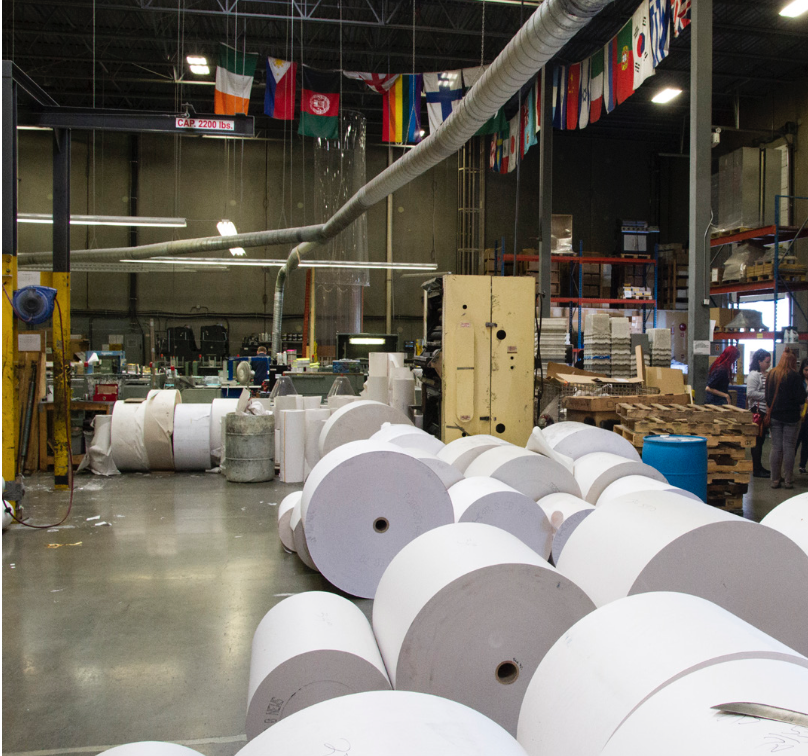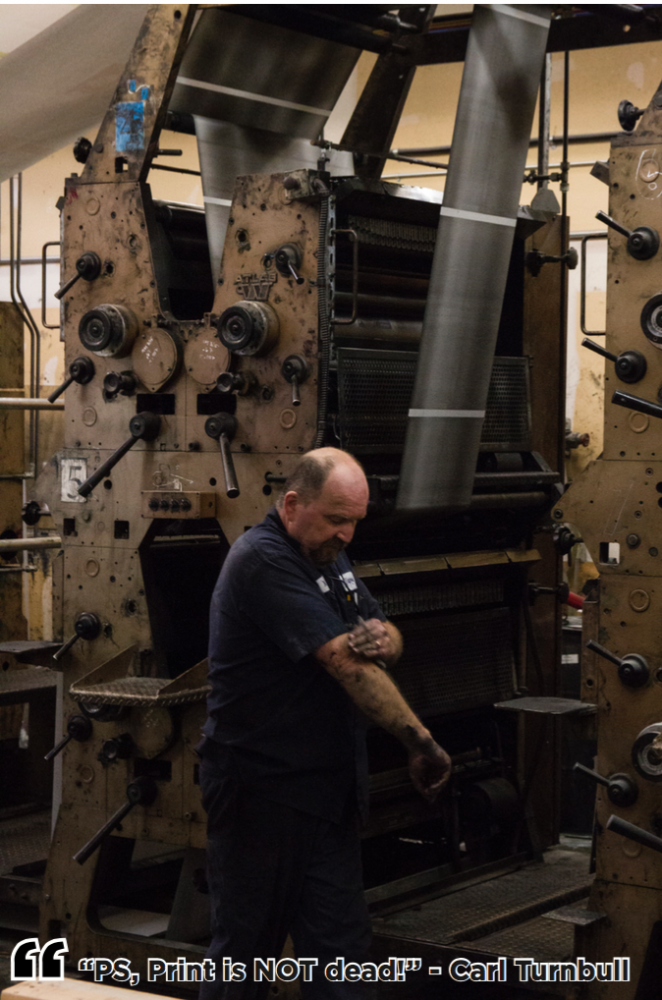By Mitch Huttema (The Cascade) – Email
Last Friday, June 17, employees of the Cascade toured the International Web exPress facilities in Coquitlam, where the newspaper is printed. WebExpress, which specializes in small-run print jobs, prints student publications from all over the Lower Mainland, including Kwantlen’s The Runner, SFU’s The Peak, and CiTR’s Discorder, as well as various other magazines and papers.
We enjoyed getting up close and personal with the process that goes on behind their ink-spotted doors, so we want to give you a sneak peek of how the publication that aims to capture UFV’s story in print physically comes to be.
All quotes below are from Web exPress Production Coordinator Tania McGuire.
“So when your file comes in, prepress works on your files. They look at where your colour pages are supposed to be and they check your files. Then they put them into a workflow called ‘Polka dot’ and it translates all of the information on each page to x and y coordinates for putting laser on the plates for writing the image.”
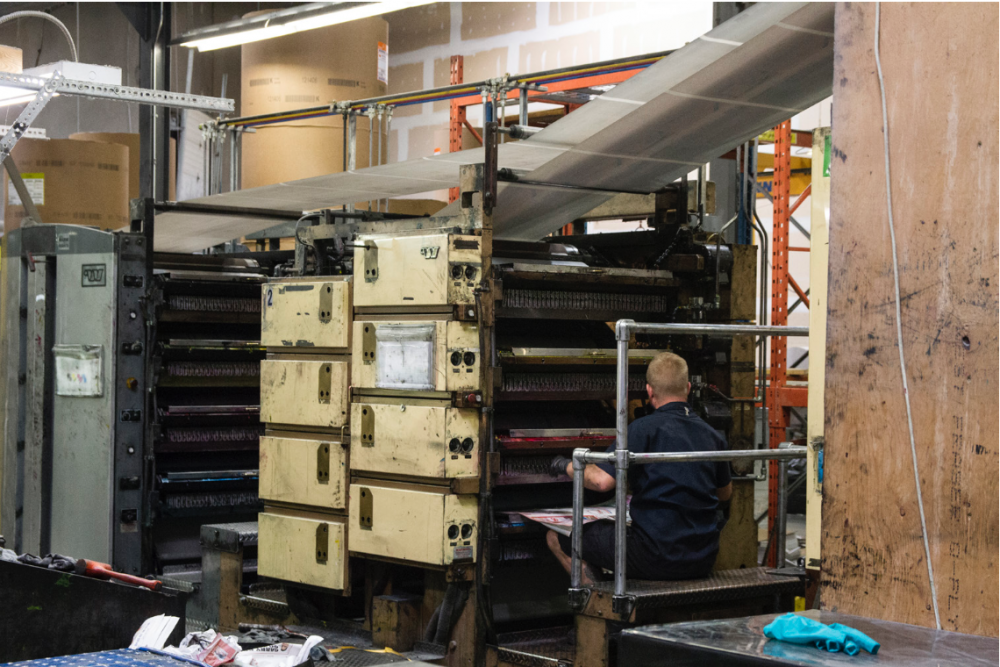
“The guys put the plates on press and they weave the paper into the right units on press and then they start printing.”
“Probably about a 15 minute setup and then it could take anywhere between half hour to an hour for the press part.”
“We have power outages and when we have power outages we stay put and wait for the power to come back on.”
“The printers are pretty old. Sometimes in the middle of the night something will break and we fall behind and we’re just a few hours late. We have electricians that are on call 24 hours a day so we can always get someone in.”
“We print a lot of papers for all the different smaller communities. We have Chinese papers, Korean, Philippine, lots of Sikh, Punjabi, Iranian, some Finnish.”
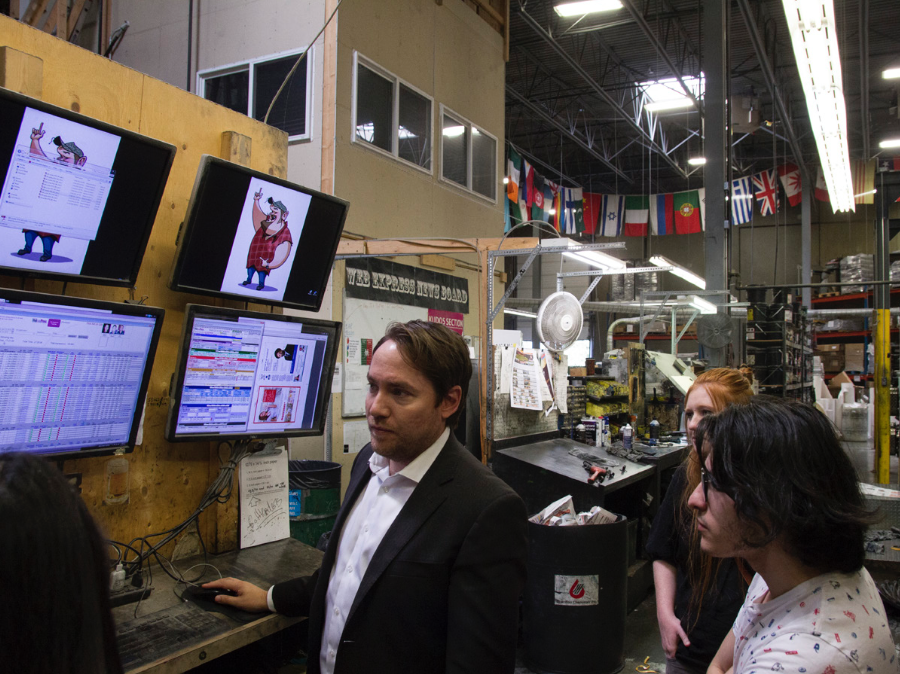
“I know that the owner here believes in free press, so I think there are a few jobs that other printers wouldn’t touch that we do sometimes.”
“We have a huge compactor here. In our bindery department, we have these big hoses that suck up all of the trim and transport it over to the compactor. Our compactor gets emptied every night, so there is a lot of paper that gets recycled.”
“We recycle everything, our aluminum plates, ink, ink pails, wood skids, the packaging that the plates come in for prepress, we use that in the bindery to separate layers on skids.”
“We have more than 150 daily, weekly, and biweekly publications in 22 languages.”
“We purchased some flags that were on the edge of our property but the city told us we’re not allowed to have them. So everything has to be on the inside of the building.”
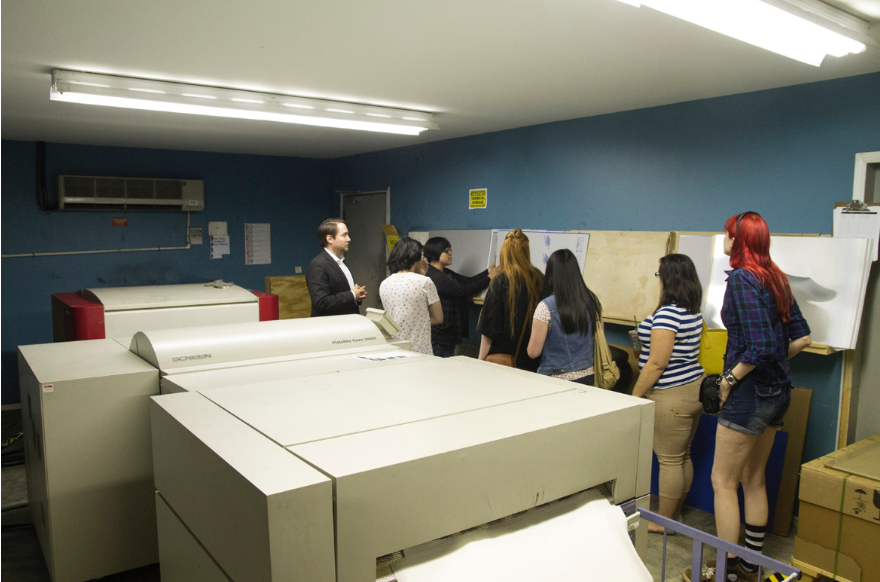
“PS, Print is NOT dead!” Carl Turnbull
What’s the step by step process?
So your file comes in, prepress works on your files. They look at where your colour pages are supposed to be and then they check your files and then they put them into a workflow called “Polka dot” and it translates all of the information on each page to x and y coordinates for the laser to put on the plates for writing the image. So it goes through our CTP, which stands for computer to plate, and you saw how the paper we print your paper on looks like a big toilet roll? When that goes through the press we print 4 pages at a time, but we print all 20 pages at the same time, but it’s 4 pages on each side of the press. The guys put the plates on press and they weave the paper into the right units on press and then they start printing.
How long does it take to print?
Probably about a 15 minute setup and then it could take anywhere between half hour to an hour for the press part. After that it goes through a bindery department and that’s where they chop a ¼ inch off the top of the paper. They’ll do a three sided trim and put the staples in. Then they’ll either fold them in half for the quarter fold or they leave them flat for the majority of your jobs.
What other publications do you have that would be relevant to students/people in Abbotsford?
We do Discorder, SFU Peak, we do the Kwantlen Runner, the UBC Ubyssey, one for Trinity Western Mars’ Hill, and then we do a lot of the leisure guides that you see at community centres.
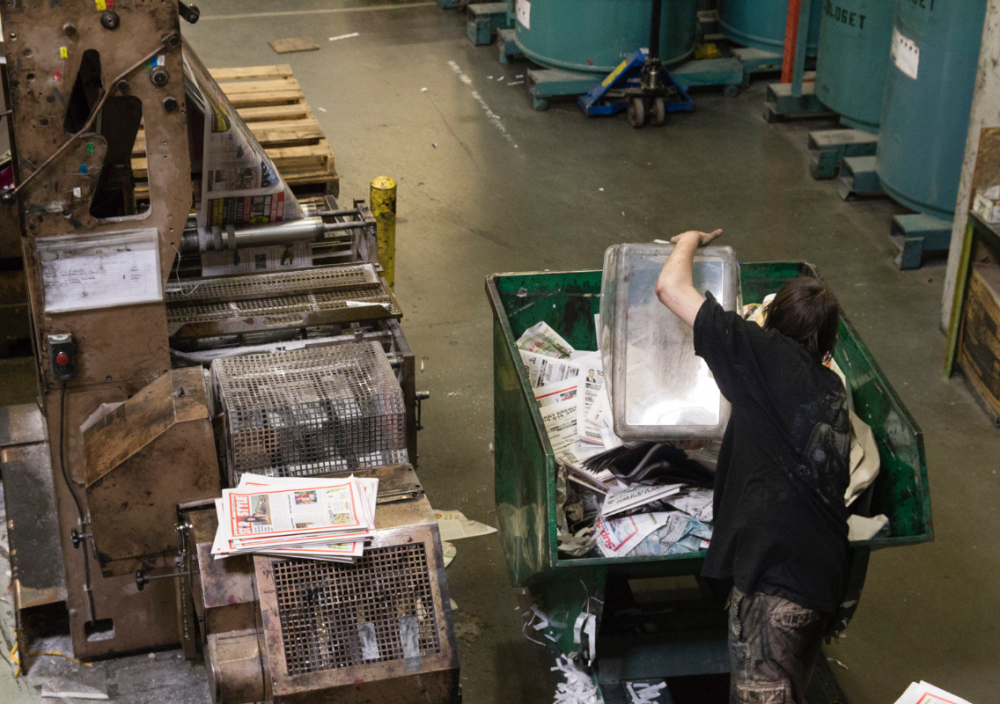
Any horror stories?
Power outages. We have power outages and when we have power outages we stay put and wait for the power to come back on. The printers are pretty old. Sometimes in the middle of the night something will break and we fall behind and then we are just a few hours late. We have electricians that are on call 24 hours a day so we can always get someone in.
What happens if we’re late in sending in our documents?
Yeah everything gets shuffled around. When I wake up in the morning I look at the schedule from the previous night and anything that’s leftover or not in, we need to figure out where it should go and we have to move it to the following day.
We noticed the flags. What’s that?
We purchased some flags that were on the edge of our property but the city told us we’re not allowed to have them. So everything has to be on the inside of the building. I think, I’m not positive.
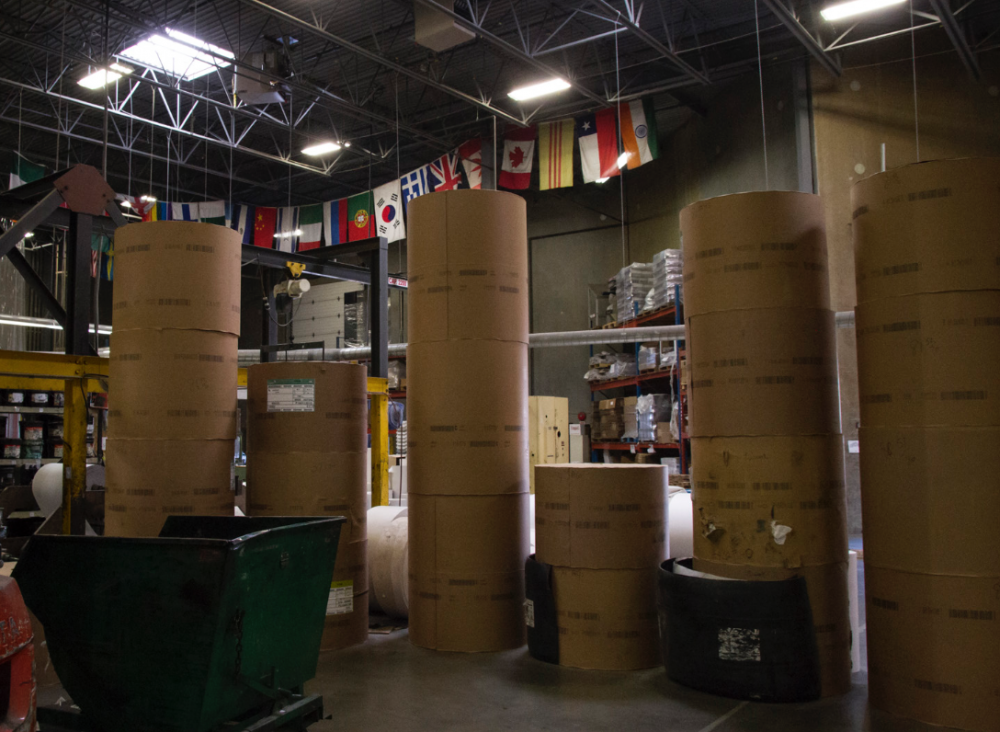
Carl mentioned your policy on free press.
I know that the owner here believes in free press, so we do, I think there are a few jobs that other printers wouldn’t touch that we do sometimes. An example would be pornographic comics, which are a little bit more difficult to get printed. We print a lot of papers for all the different smaller communities, we have Chinese papers, Korean, Philippino, lots of Sikh, Punjabi, Iranian, some Finnish.
What’s the furthest away that you print?
We have a few customers that have different shipment that will go sometimes to any of the States or sometimes to Ontario. Nothing further, to my knowledge, but it’s a special setup if it’s shipping further away.
A lot assume that we have something to do with the internet because it has the word web in it. It’s has the word web because it’s web printing there’s sheet side printing, which is single sheets, and then the web, which is the huge sheets and it gets webbed through the machine, it’s referred to as web printing.
Philosophy around smaller jobs?
I remember 10 years ago, we wouldn’t touch anything that was less than 1000 copies, but there are definitely jobs that print lower quantity. You could say that we specialize in the shorter runs. I’ve seen quantities for as low as 500. I don’t have much to do with pricing, but I’m sure it would come with the same amount of setup and waste to get the job going, so it’s probably more per copy even though you’re doing smaller amounts.
We have a huge compactor here and then in our bindery department, we have these big hoses that suck up all of the trim and transport it over to the compactor. Our compactor gets emptied every night, so there is a lot of paper that gets recycled. We recycle everything, our aluminum plates, ink, ink pails, wood skids, the packaging that the plates come in for prepress, we use that in the bindery to separate layers on skids.
We have more that 150 daily, weekly, and biweekly publications in 22 languages. Per day, about 40 sections, so a job is about 2 sections, so 40 signatures.
